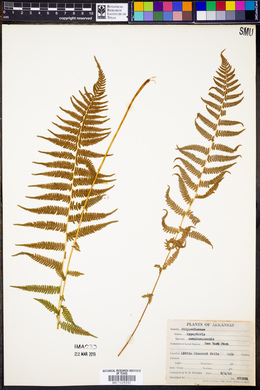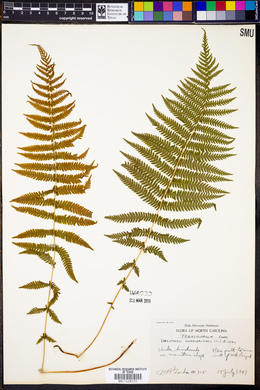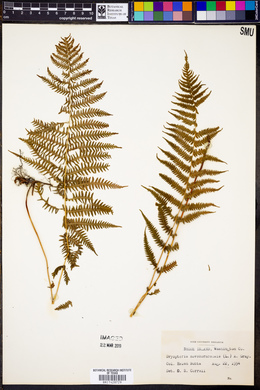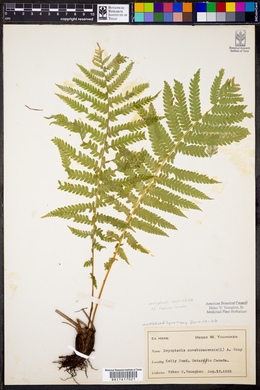Thelypteris noveboracensis
|
|
|
|
Family: Thelypteridaceae
New York Fern, more...New York Fern
[Aspidium noveboracense (L.) Sw., moreDryopteris noveboracensis (L.) A. Gray, Parathelypteris noveboracensis (L.) Ching, Thelypteris thelypteroides (Michx.) Holub] |
Perennial fern 25 - 80 cm tall Leaves: all of similar shape, green, 15 - 60 cm long, up to 15 cm wide, elliptic in outline, but pinnately compound with deeply pinnately lobed leaf divisions (pinnae), and a gradually tapered, pinnately-lobed tip. All leaves die back in winter. Rhizome: usually long-creeping, 1.5 - 2.5 mm in diameter, and scaly at apex. Leaf stalks: spaced 1 cm or more apart, straw-colored, 4 - 25 cm long, 1 - 3 mm wide, darker near base due to tan to reddish brown, egg-shaped scales. Spores: numerous, all of one kind, and single-sectioned (monolete). The spores are released from July to October, and give rise to the gametophyte (the sexual phase of the plant), which is small, green, heart-shaped, usually hairy or glandular, and sits above the ground. Similar species: In the Chicago Region, Thelypteris noveboracensis is most similar to T. palustris var. pubescens, but in that fern the lowest pairs of leaf divisions (pinnae) are only slightly shorter (if at all) than the ones in the middle of the leaf, the pinnae "midribs" (costae) often have a few, small, tan scales on their underside, but the blade tissue is always hairless. Probably the most similar species to T. noveboracensis in North America is the far western species T. nevadensis. That species, however has the pinnae "midribs" (costae) almost hairless with the hairs only up to 0.7 mm long, and the undersides of the pinnae have numerous yellow to orange, short-stalked glands. Also similar are our two species of Phegopteris, P. connectilis, and P. hexagonoptera, but both of those species have leaf blades with at least the uppermost leaf divisions (pinnae) not fully divided to the "midrib" (rachis) with connecting tissue between the pinnae, and the "midribs" of the pinnae (costae) are not grooved on the upper side. Members of the Dryopteridaceae family (genera such as Dryopteris, Cystopteris, Woodsia, Athyrium, and Deparia) may be confused with this species, but members of that family lack needle-like hairs, often possess scales on the leaf blades (not just the costae), the leaf blades are typically compoundly divided much more than once, and the veins on the final leaf divisions often fork. Habitat and ecology: Rare except in the eastern counties, usually in rich mesic forests or wet-mesic swamps, especially on moist raised areas (hummocks). Occurence in the Chicago region: native Notes: In a very wide sense, the genus Thelypteris is an incredibly large and complex genus of approximately 900 species, and it would be the only genus in the Thelypteridaceae family. Some have divided the genus into about thirty other genera, which are treated as subgenera or sections by various taxonomists. We follow the Flora of North America (1993), which separates only two other distinct groups as separate genera: Phegopteris and Macrothelypteris. This species is in the subgenus Parathelypteris, which can be distinguished from the other subgenera of Thelypteris by having leaves that die in winter, narrow and long-creeping rhizomes (only up to 3 mm diameter), singly pinnate leaves that are further deeply pinnately lobed (pinnate-pinnatifid), greatly shortened lower leaf divisions (pinnae), and veins that join the leaf blade edge above the lowest point of the pinnae lobes. Author: The Field Museum Rhizome with a few pale, appressed, lance-ovate scales, otherwise glabrous; lvs to 9 dm, the petiole dark and scaly at the base, sparsely hairy, 12-20 cm, much shorter than the blade; blade narrowly lance-elliptic, acuminate, to 15 cm wide, pinnate- pinnatifid, gradually narrowed below, the lower pinnae reduced to mere rudiments; pinnae many pairs, sessile, lance-linear, to 15 mm wide, with linear-oblong, obtusish, subentire segments; rachis, costa, and veins hairy, without scales; veins simple or rarely a few forked; indusia pale, long-ciliate; 2n=54. Mixed woods and swamp-margins; Nf. to Ont. and se. Wis., s. to Ga., Ala., and Ark. (Aspidium n.; Dryopteris n.) Gleason, Henry A. & Cronquist, Arthur J. 1991. Manual of vascular plants of northeastern United States and adjacent Canada. lxxv + 910 pp. ©The New York Botanical Garden. All rights reserved. Used by permission. From Flora of Indiana (1940) by Charles C. Deam This species is found only in slightly acid soil, hence its zonal distribution. It is infrequent to local in the northern part of the state where it usually occurs in black and white oak woods. It is rare or absent in the Tipton Till Plain, becoming infrequent to frequent southward in the hard, white clay soil of beech and sweet gum woodland. In the southern part of the state is is usually closely associated with beech. …… Indiana Coefficient of Conservatism: C = 5 Wetland Indicator Status: N/A |





























































































